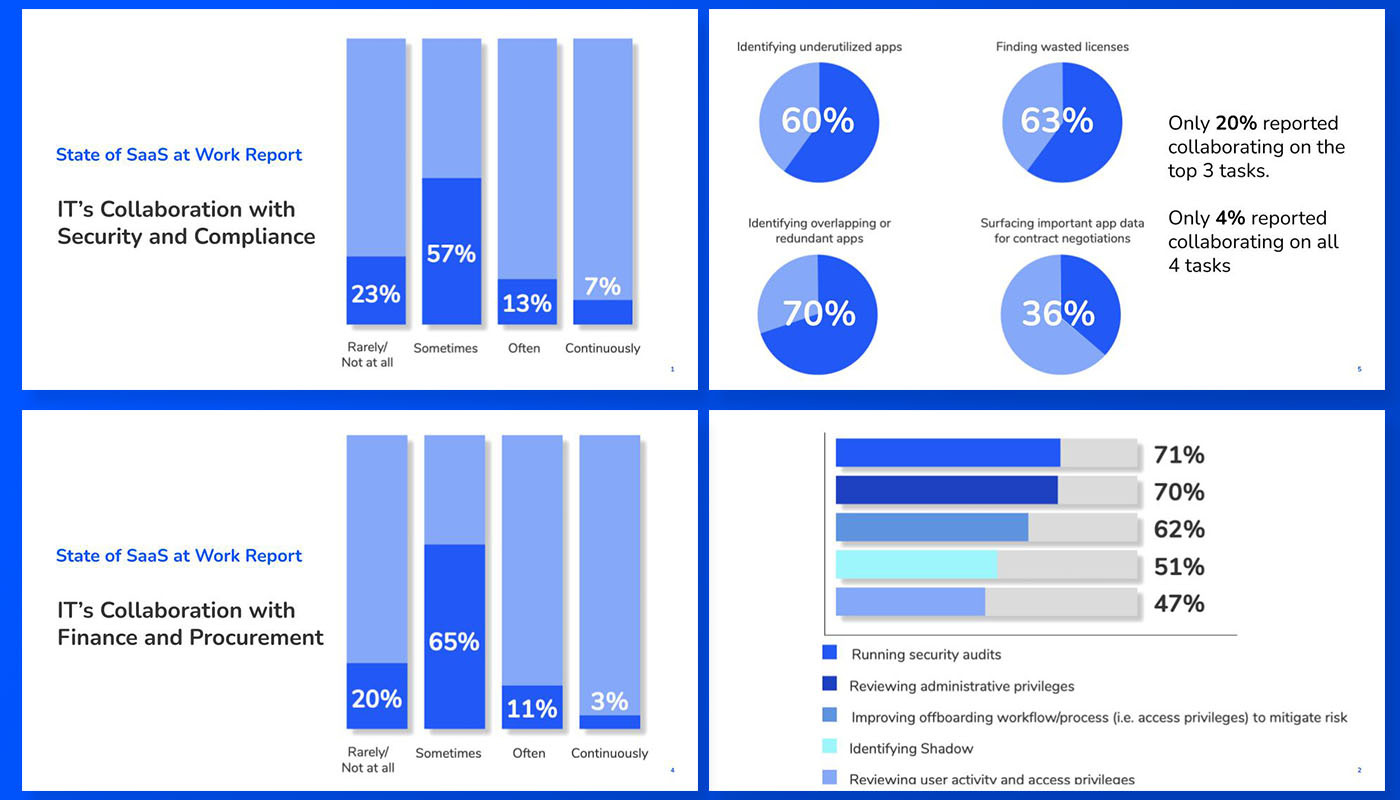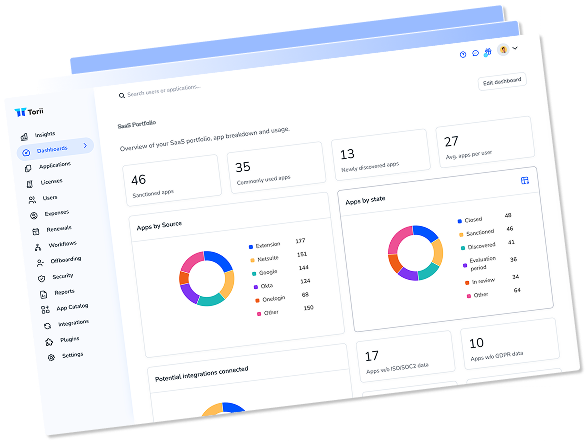SaaS applications are the bread and butter of the modern workplace. But since their emergence, they have changed the way we adopt software. Instead of IT and Procurement teams serving them up, we now get SaaS apps in a more buffet style, picking and choosing what we want without consulting the menu.
In non-food terms, adoption has steadily shifted from IT’s sole control to a more distributed practice, where (nearly) anyone has the power to try, integrate, and buy applications of their own volition. But with great power comes great responsibility—and frankly, people are dropping the ball, especially regarding cross-functional collaboration.
Collaboration is a buzzword you might be burnt out on hearing, but without collaboration between IT, cross-functional peers, and SaaS stakeholders, scattered SaaS creates a disconnect. It’s a disconnect between priority and action, data and goals, and between perception and reality. And ultimately, this breakdown costs organizations time, money, and even employee satisfaction as they attempt to make decisions with only a partial understanding of the full SaaS story.
The State of SaaS at Work Report examines the tough truths of collaboration in our distributed workplace with some truly jaw-dropping numbers revealing how team members fail to collaborate on shared responsibilities based on critical data.
Keep reading for the quick and dirty lowdown on three standout takeaways, or jump to the full report.
Takeaway 1: Cognitive Dissonance Runs Rampant
Distributed SaaS adoption is embraced as the new normal, and for good reason. It allows for faster innovation, greater department autonomy over apps, and more consideration for end-user preferences. However, 62% of respondents also said distributed SaaS makes it more difficult for IT to collaborate across different departments.
If you’re reading this, shaking your head, thinking, “My IT team definitely has good, collaborative working relationships with other teams,” you’re in good company. The State of SaaS at Work report also found that 90% of respondents rate overall collaboration between IT and other teams as “Good or Excellent.” But there is a distinct difference between perception and reality. In fact, barely 20% of IT departments proactively collaborate “often” or “continuously” with specific departments on key SaaS management tasks:
- 14% with Finance and Procurement teams to maximize SaaS investments
- 20% with Security and Compliance teams to discover hidden applications
- 19% with Line of Business leaders to optimize the use of cloud applications
- 17% with Human Resources to improve employee onboarding and offboarding
The drivers behind this cognitive dissonance and collaborative difficulties are twofold.
First, we have a vague definition of collaboration. Often it simply means any activity that involves two or more people. But effective collaboration is not just about adding more cross-functional meetings to your calendar, sending quarterly email updates, or helping peers put out technical fires. It’s about getting things done strategically.
Instead of vague promises of working together, we can boil collaboration down to three specific requirements. Collaboration requires:
- Shared insight into critical data
- Collective understanding of business goals
- Alignment on execution toward those goals
That’s it. No matter how many working sessions, or standups you have, if you lack those three ingredients, you lack collaboration. Unfortunately, many of today’s organizations miss those steps in their attempts to optimize their sprawling, distributed SaaS stacks.
The second and most persistent challenge to cross-functional collaboration is the level of visibility (or lack thereof) that IT has into the full SaaS stack. Scattered app ownership creates SaaS silos where critical information is out of IT’s reach, stripping them of the ability to be strategic, collaborative, data-driven SaaS advisors to their peers.
General visibility is a problem, but there’s also the specific lack of visibility known as “Shadow IT.”
Takeaway 2: Shadow IT’s Presence Persists
In the State of SaaS at Work Report, 57% of respondents reported that individuals or line of business owners are allowed to purchase applications without IT’s knowledge. For the other 43%, purchases outside of IT’s purview might not be “allowed,” but it doesn’t necessarily mean it’s not happening.
Gaining visibility of IT-approved, sanctioned apps is one thing, but uncovering and proactively managing Shadow IT is a different ball game. It requires teamwork between IT, security, and compliance, so opponents can’t steal home.
In another recent Torii report, we found that 69% of IT executives consider Shadow IT the top security risk associated with SaaS, and a large majority (80%) of lapsing security protocols were attributed to apps adopted outside of IT’s purview.
Surprisingly though, only 20% of State of SaaS at Work respondents stated that IT collaborates with Security and/or Compliance “often” or “continuously” to discover hidden applications.
Without collaboration and automated discovery tools, it’s hard (if not impossible) to know when Shadow IT enters your SaaS stack, which is why it comes with risks. You can’t protect or secure something you don’t know exists.
Takeaway 3: IT is still Optimistic about Distributed App Adoption (Despite the problems it presents)
At a glance, distributed SaaS adoption offers faster innovation, greater department autonomy over apps, more consideration for end-user preferences, and perhaps best of all, 49% of our respondents say it frees up IT resources. These benefits don’t go unnoticed, and our results indicate an overall positive sentiment for distributed adoption, with 80% of respondents believing it is either “good” or “excellent” while still being cautious about the risks.
These positive feelings might be due to IT recognizing the power of an empowered, distributed workforce, or they might accept that distributed adoption is unavoidable. Regardless, the challenges and any downsides are addressable!
Organizations can mitigate the downsides and elevate the opportunities of a Distributed SaaS Management strategy, but IT can’t do it alone. Distributed SaaS Management is a team sport. IT teams can draw up the playbook but need all the players on the field (i.e. SaaS app owners and stakeholders) to be aligned to execute the plays (i.e., SaaS spend optimization, Shadow IT management, vendor negotiations, and more).
Your team may also need some new equipment. One of the reasons organizations may be reluctant to add more collaborative processes is that it’s perceived as more work. Still, a SaaS management platform like Tori—which 64% of IT professionals have on their wish lists—can minimize busy work, centralize reliable SaaS app data, and give every player an assist to win the game.
Interested in reading the full State of SaaS at Work report? Download it here.

